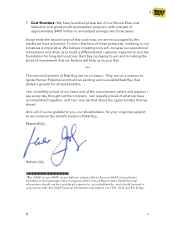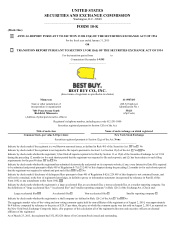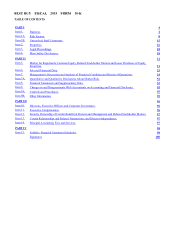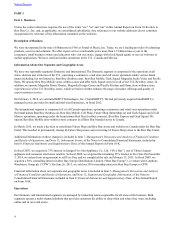Best Buy 2015 Annual Report Download - page 17
Download and view the complete annual report
Please find page 17 of the 2015 Best Buy annual report below. You can navigate through the pages in the report by either clicking on the pages listed below, or by using the keyword search tool below to find specific information within the annual report.
Table of Contents
10
Failure to effectively manage our costs could have a material adverse effect on our profitability.
Certain elements of our cost structure are largely fixed in nature. Demand for our products and services is difficult to predict,
which makes it more challenging for us to maintain or increase our operating income. The competitiveness in our industry and
increasing price transparency mean that the focus on achieving efficient operations is greater than ever. As a result, we must
continuously focus on managing our cost structure. Failure to manage our labor and benefit rates, advertising and marketing
expenses, operating leases, other store expenses or indirect spending could severely impair our ability to maintain our price
competitiveness while achieving acceptable levels of profitability.
Our liquidity may be materially adversely affected by constraints in the capital markets or our vendor credit terms.
We need sufficient sources of liquidity to fund our working capital requirements, service our outstanding indebtedness and
finance investment opportunities. Without sufficient liquidity, we could be forced to curtail our operations or we may not be
able to pursue business opportunities. The principal sources of our liquidity are funds generated from operating activities,
available cash and liquid investments, credit facilities, other debt arrangements and trade payables. Our liquidity could be
materially adversely impacted if our vendors reduce payment terms and/or impose tighter credit limits. If our sources of
liquidity do not satisfy our requirements, we may need to seek additional financing. The future availability of financing will
depend on a variety of factors, such as economic and market conditions, the regulatory environment for banks and other
financial institutions, the availability of credit and our credit ratings, and our reputation with potential lenders. These factors
could materially adversely affect our costs of borrowing and our ability to pursue growth opportunities, and threaten our ability
to meet our obligations as they become due.
Changes in our credit ratings may limit our access to capital and materially increase our borrowing costs.
In fiscal 2015, Moody's Investors Service, Inc. maintained its long-term credit rating at Baa2 and revised its outlook from
Negative to Stable. Fitch Ratings Ltd. upgraded its long-term credit rating from BB- to BB, maintaining its outlook as Stable.
Standard & Poor's Ratings Services maintained their long-term credit rating at BB with a Stable outlook.
Future downgrades to our credit ratings and outlook could negatively impact our access to capital markets, the borrowing cost
for future financings and the perception of our credit risk by lenders and other third parties. Our credit ratings are based upon
information furnished by us or obtained by a rating agency from its own sources and are subject to revision, suspension or
withdrawal by one or more rating agencies at any time. Rating agencies may change the ratings assigned to us due to
developments that are beyond our control, including the introduction of new rating practices and methodologies.
Any downgrade may result in higher interest costs for certain of our credit facilities and could result in higher interest costs on
future financings. In addition, downgrades may impact our ability to obtain adequate financing, including via trade payables
with our vendors. Customers' inclination to shop with us or purchase gift cards or extended warranties may also be affected by
the publicity associated with deterioration of our credit ratings.
Failure to effectively manage strategic ventures or acquisitions could have a negative impact on our business.
From time to time, our strategy has involved, and may in the future involve, entering into new business ventures and strategic
alliances, as well as making acquisitions. Assessing a potential opportunity can be based on assumptions that might not
ultimately prove to be correct. In addition, the amount of information we can obtain about a potential opportunity may be
limited, and we can give no assurance that new business ventures, strategic alliances and acquisitions will positively affect our
financial performance or will perform as planned. The success of these opportunities is also largely dependent on the current
and future participation, working relationship and strategic vision of the business venture or strategic alliance partners, which
can change following a transaction. Integrating new businesses, stores and concepts can be a difficult task. Cultural differences
in some markets into which we may expand or into which we may introduce new retail concepts may not be as well received by
customers as originally anticipated. These types of transactions may divert our capital and our management's attention from
other business issues and opportunities and may also negatively impact our return on invested capital. Further, implementing
new partnerships, strategic alliances or business ventures may also impair our relationships with our vendors or other strategic
partners. We may not be able to successfully assimilate or integrate companies that we acquire, including their personnel,
financial systems, distribution, operations and general operating procedures. We may also encounter challenges in achieving
appropriate internal control over financial reporting and deficiencies in information technology systems in connection with the
integration of an acquired company. If we fail to assimilate or integrate acquired companies successfully, our business,
reputation and operating results could suffer materially. Likewise, our failure to integrate and manage acquired companies
successfully may lead to impairment of the associated goodwill and intangible asset balances.
























